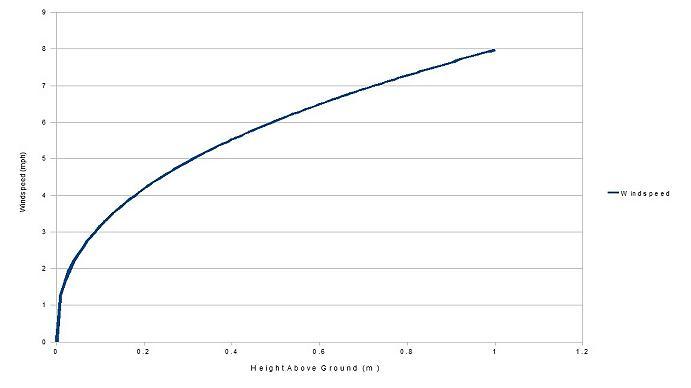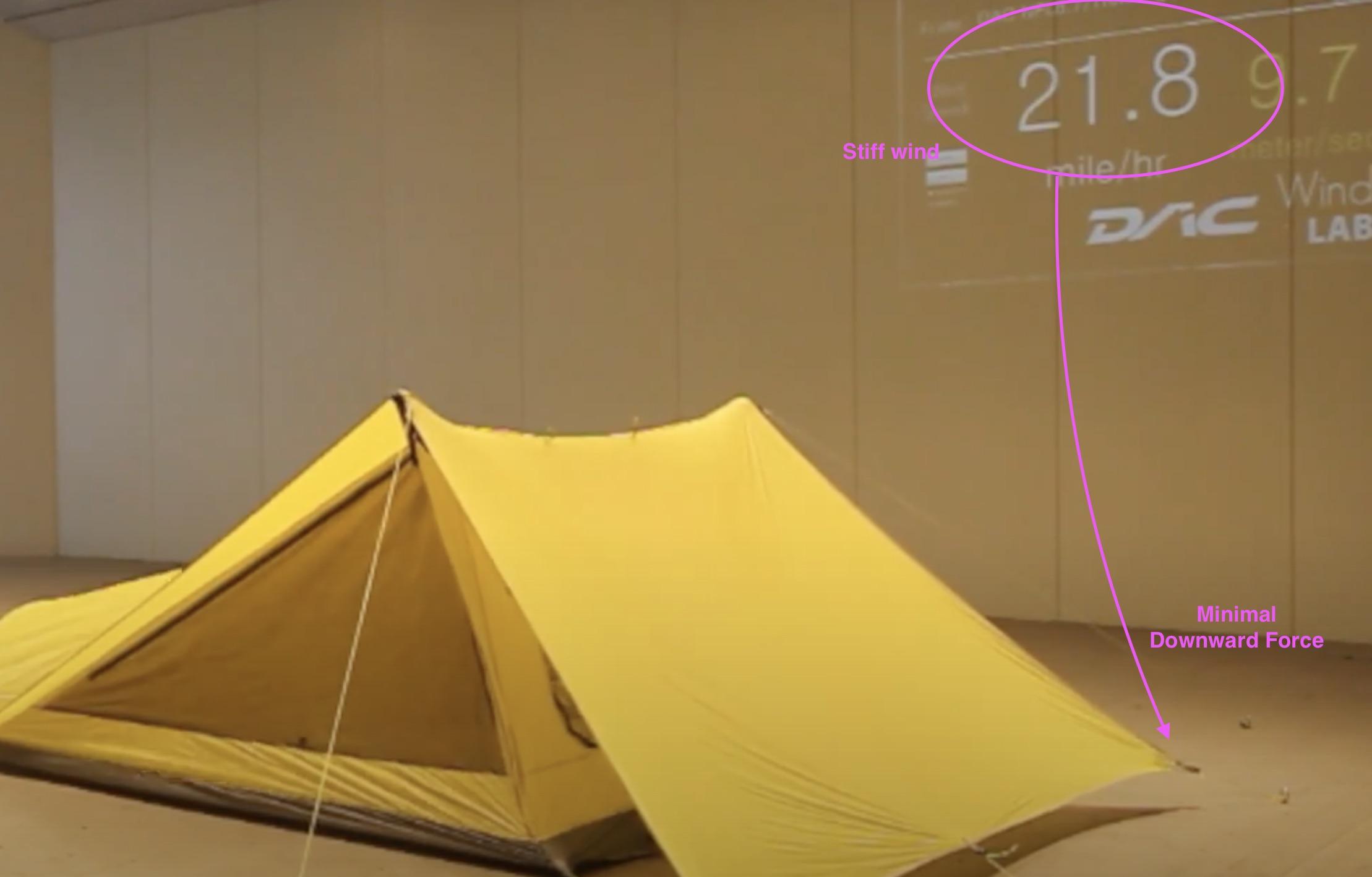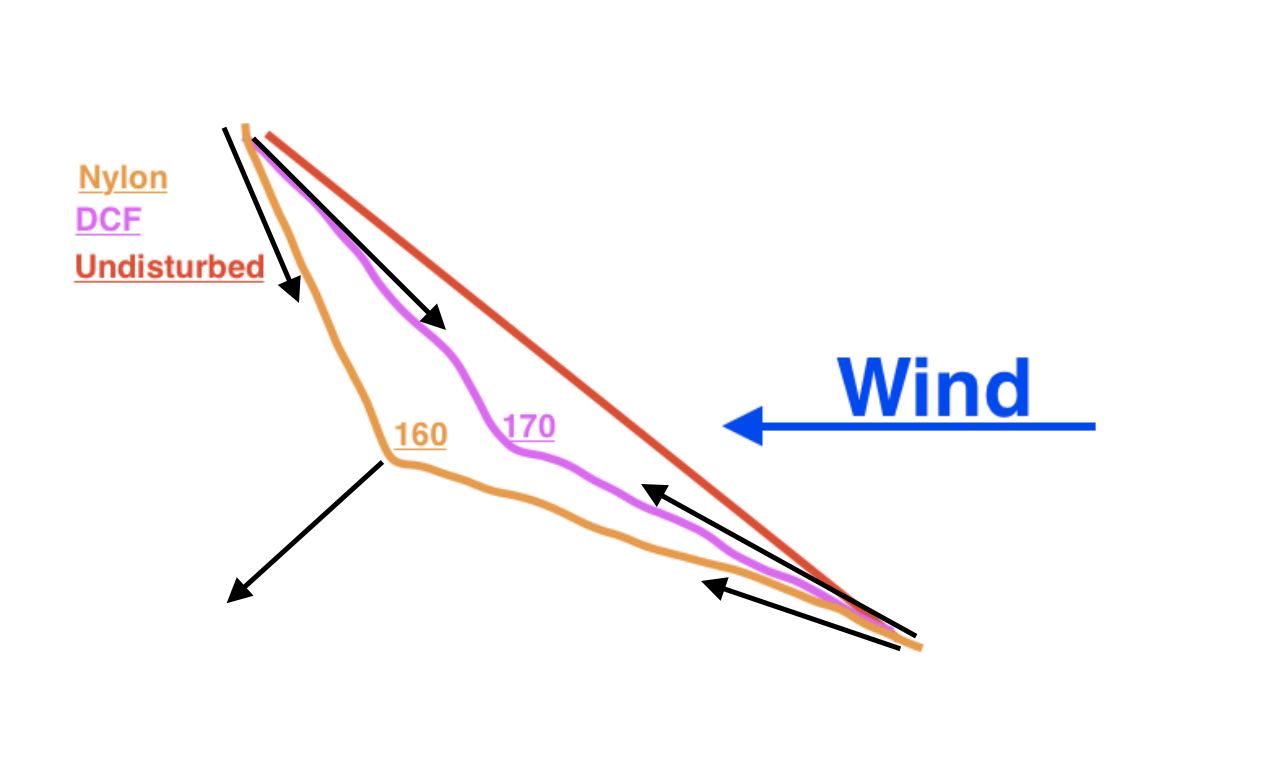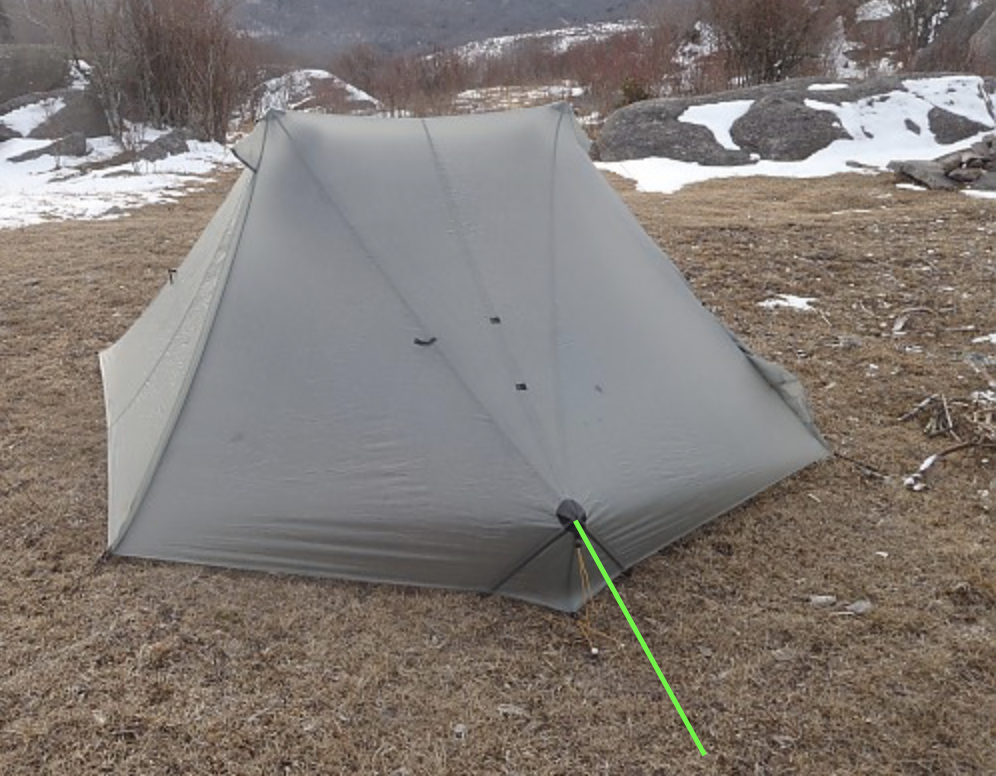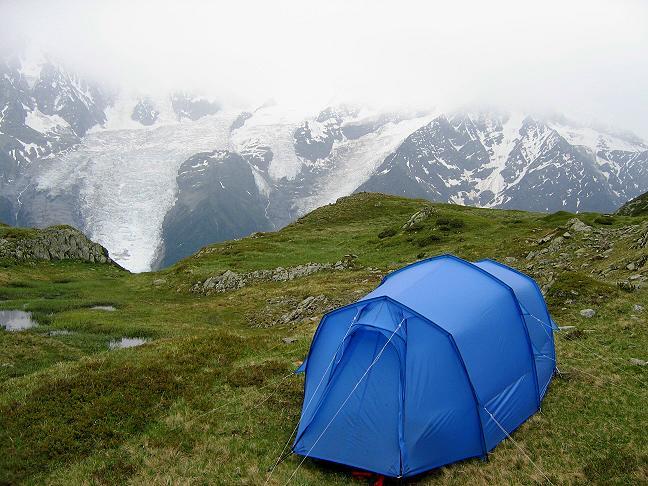Topic
So I have a new Tent plan for 2021…input welcome
Forum Posting
A Membership is required to post in the forums. Login or become a member to post in the member forums!
Home › Forums › Gear Forums › Gear (General) › So I have a new Tent plan for 2021…input welcome
- This topic has 176 replies, 35 voices, and was last updated 4 years, 1 month ago by
 Roger Caffin.
Roger Caffin.
-
AuthorPosts
-
Dec 12, 2020 at 2:07 am #3688486
Not mentioned so far about the wind calculations is the wind profile.

Wind is close to zero at ground level, rising to its full speed about 1 m above ground (depending on scrub etc). I am sure that will do something to the results, but I am not going to try to predict what.
Cheers
Dec 12, 2020 at 6:20 am #3688493At this point, maybe we should break out the load sensor rig and get a Tarptent Notch out into the Wyoming wind.
What do y’all think is the best way to compare the effect of a Notch strut to a “no-strut” control?
And should I use the sil or dcf canopy?
I’ve been thinking on this idea: actually measure the load on a staking point to see what’s happening. Ideally we could put tents in a wind tunnel with load sensors all over the place, but I don’t see that happening…so what’s the best analog for the question at hand, aside from a full tent in controlled wind? Can a physical model be made? Can the various diagrams be quickly rendered into a test rig? I thought about using a simple scale, and approximating the conditions with basic pieces of fabric, rope, etc.
Dec 12, 2020 at 9:35 am #3688522Wow my post got more responses then I expected and I’m loving all the input, especially on Tent geometry and design discussions. Looks like I opened a can of worms. Thanks for all the diagrams also! Makes more since when you can visually see what is explained, even if that math and formulas are a little out of my abilities. In reality though it seems, no matter what, mother nature and real life experience contribute to the learning curve. This is where this group shines and brings a lot of experience to the table. Thanks for all the input its greatly appreciated!
Dec 12, 2020 at 12:45 pm #3688558“Can a physical model be made?”
I think the only outstanding question here is: What force is applied at the corner when wind hits the tent?Is it perpendicular to the panel as Alexandre’s “wind” calculations assume, which would be downwards on the corner (as shown below) where the strut would take most of the stress off the stake:

Or is it parallel to the panel, as I say, where struts would result in higher stress on the stake – potentially far higher if staked close to the strut – as Alexandre’s first “non wind” calculations show.
I think the latter is correct, as a force parallel to the fabric/rope is what force diagrams show:

And it’s I think obvious when you imagine tying a rope to something and pulling. Can you tie a rope to a cow and pull that cow in a direction that is not in line with the rope? No. You can only pull it towards you.But yes we can easily test this with a physical model. Grab a strong rope and tie it between two sturdy chairs. Then step onto the rope and see what happens to those chairs (which are analogous to our corner and peak). If the force on the chairs is perpendicular to the rope it will be straight down on the chairs, so the chairs will not budge and you can stand on the rope just like if you put a board between the two chairs. But if the force is parallel to the rope then the chairs will be pulled inward where they will slide or topple towards the center. This is obviously the true outcome, which is why someone using a slack line has to tie it between two sturdy trees and not two chairs.
“Ideally we could put tents in a wind tunnel with load sensors all over the place, but I don’t see that happening”
Just look at wind tunnel videos on YouTube. It’s clear there is very little downward force on the corner when wind hits the side of the tent because these corners are easy to push to the ground yet don’t hit the ground until the tent is actually collapsing lower extreme winds.

“should I use the sil or dcf canopy?”
The answer to that is here:

A DCF canopy will stretch/deflect less to stay closer to 180 degrees and thus put greater forces on the stake and peak, and in a worse direction.
It would look something like this

There wouldn’t actually be a sharp bend since the wind is hitting all over. There would be a curve (“scooping”) but the physics are the same where the deeper scoop creates less force on either end, and is pulling more horizontally on the stake. So DCF will give greater forces on the stake and at a more upward angle.
Dec 12, 2020 at 1:19 pm #3688561Grab a strong rope and tie it between two sturdy chairs. Then step onto the rope and see what happens to those chairs. If the force on the chairs is perpendicular to the rope it will be straight down, so the chairs will not budge and you can stand on the rope. But if the force is parallel to the rope then the chairs will be pulled inward where they will slide or topple towards the center. This is obviously the true outcome, which is why someone using a slack line has to tie it between two sturdy trees and not two chairs.
It seems that this is an argument of reference points, and one that’s understood to be an oversimplification for the sake of clarity…which is fine, as long as we recognize it as such. Sure, we know what happens in this kind of model because common sense dictates it, but I’m concerned that the three-dimensional geometry – and the associated strengths and weaknesses thereof – in a tent will have effects that we can’t predict via a more simplified view of things; common sense dictates this, as well. So, my question about a model still stands, although we already know the answer: of course a model can be built… it’s just a question of whether or not one of us can build it and test it. With that in mind, there’s really only one ironclad way I can envision to answer this with realistic data: build two tents that are identical except for a selected corner or corners. On one, the fabric panels extend all the way to the staking points; on the other, certain corners are constructed with struts in a realistic, usable way. The chosen corners are then subjected to controlled loads from controlled directions, and the transferred loads from those corners are measured via a sensor. After data are generated, the compilation thereof should be able to tell us exactly what’s happening.
Realistically, this isn’t a great plan: it’s expensive, time-consuming and likely unachievable without access to some very specific testing equipment and environments. So, a better question is this: how do we approximate that kind of comprehensive test in an easy, affordable and repeatable way? That’s where I’m drawing a blank.
Dec 12, 2020 at 2:43 pm #3688574Certainly a tent is a 3D object. What you’ll find though is that any panel connecting to that corner can only pull on that corner in line with that panel. So if we have 3 panels connecting at a corner they could each pull like this:

The sum of those panels pulling on the corner is going to depend on a few factors like the angle of the wind (e.g. how hard it is hitting each panel) and the size of those panels, but the combined force vector can never be down since only a little fabric is below the top of the strut. The combined force vector will always been pulling in and probably a bit up on the tip of the strut, causing it to try to rotate as it pivots inward around its base.
Several pages ago I provided diagrams with measurements to demonstrate how it is possible to have a 2:1 ratio between movement at the tip of the strut and movement at the stake. This ratio is all that matters when the force is overwhelmingly in that direction – which it unavoidably is (because the surface area that is catching the wind is on that side of the strut). The wind blows, the strut tip is pulled inward, and ~2:1 leverage is applied on the stake.
To do a real world demonstration, someone could grab a strut tent and measure the force on the stake during a stiff wind. Then remove the struts and extend the lines out to where the full canopy would be if the corner hadn’t trimmed it off, like this:

It would be more stable to off axis winds if you added a bunch of cords to closer simulate the full fabric panels being there as shown below, but it doesn’t really change the combined force on the stake.
 Dec 12, 2020 at 6:23 pm #3688607
Dec 12, 2020 at 6:23 pm #3688607I am not sure what problem is trying to be solved now. It seems to me the problem to be solved is keeping stakes in the ground during high winds while maximizing interior space and minimizing the required foot print. Is that correct?
I had to go back to the first page – the original post was asking about experience with the Tarptent SS1. Lmao.
Dec 12, 2020 at 6:52 pm #3688613Well, yes, in principle.
But please remember that tents have been pitched at altitude in high winds with just Ti wire stakes, and stayed up.
I do not think the tent stakes are the problem – assuming they are used correctly. And one can usually add rocks when at high places.Stopping the tent from collapsing in high wind – that is more a matter of tent design. I imagine most readers know my opinions about that.
Cheers
Dec 12, 2020 at 6:54 pm #3688614It is widely agreed that struts can increase space and reduce footprint, so the drawn out question here is under what circumstances do struts make stakes more likely to rip out?
We’ve established that struts can add a lot of leverage and now we are primarily discussing the conditions under which that occurs (e.g. wind?). An inward pull on the strut subjects the stake to greater stress (versus no strut) so the specific question is what are the force vectors from natural conditions like wind (and also snow etc).
Dec 12, 2020 at 7:09 pm #3688616An inward pull on the strut subjects the stake to greater stress (versus no strut)
No proof or evidence is offered.
There might be minor differences, either way. I do not agree in principle.Cheers
Dec 12, 2020 at 7:36 pm #3688620“No proof or evidence is offered.”
I’m surprised to hear you say that. There has been extensive proof and evidence offered on multiple occasions throughout this thread.I demonstrated this with diagrams and calculations at the bottom of page two to mathematically show that a common strut setup results in >200% force on the stake. Another poster affirmed those calculations with their own, to also show that an inward pull can create leverage via their own calculations:

Here they show an inward force vector (Ftension) on the strut multiplies the force on the stakes (Frope) such that the latter is greater than having no strut, particularly when the stake is positioned close to the strut. This adds to what I showed by demonstrating how much additional stress is added across the range of angles a stake might be located at. There is always additional stress on the stake if you have a strut corner and an inward pull, unless the stake is located out so far that it is directly in line with panel (like a non-strut corner) or further.Dec 12, 2020 at 8:09 pm #3688630Hi Dan
There has been extensive proof and evidence offered on multiple occasions throughout this thread.
Well, no.
You see, as a physicist I specialise in measurement in the very real sense. I have seen diagrams and equations and theories and so on, but I have not seen any measurements from the field (yet).Going into preachy mode:
Theories are great, but they are only of value if they make predictions which can be tested in the real world. Only too often we find that the real world is different, usually because the theory masks some unstated and untested assumptions.
This is why we always insist of testing a theory in the real world.Phlogiston was a great theory – until it was tested.
The Ether was a great theory – until it was tested.
The Earth-centered Universe was a great theory – until it was tested. OK, Galileo got into trouble briefly for testing it.In this case, none of the tent theories even mentions the assumption that wind speed is constant all the way down to the ground. From experiment, we know that assumption is completely false.
Experiment shows tents doe not collapse from the bottom up, but rather from the top down. Windspeed profile.
MEASURE!
Cheers
Dec 12, 2020 at 8:32 pm #3688637You just figured it out, Roger: the phlogiston is the issue. When there’s too much of it in the tent fabric and struts, they start sagging…and if the wind blows hard enough, they spontaneously combust: that’s because wind is an oxidizer.
Dec 12, 2020 at 9:18 pm #3688639In this case I said something very specific (“an inward pull on the top of the strut creates leverage on a closely positioned stake“). That can and has been fully defined by an equation to prove with 100% certainty that this specified leverage exists. It’s an equation not a theory, just like 1 + 1 = 2 is not a theory.
What I think you’re getting at though is the theory that this equation adequately describes what’s happening with a tent in the field. Of course this equation doesn’t not fully describe what’s happening in the field since there are other variables at play (e.g. spatiotemporal variation in wind speed, uneven surfaces, stretch etc). Certainly we should do some field tests to make sure we’re not missing something important, but we can be confident that this core leverage equation exists.
Dec 12, 2020 at 9:26 pm #3688641Thank you Bonzo.

Quite likely you may have seen this before, but I will use it to illustrate what I am saying.First of all, there was quite a strong wind blowing towards Mt Blanc in the background, but you will notice that the bottom edge of the tent is not being distorted. That is because the windspeed at ground level is very low. (If it wasn’t, it would be stripping the grass off the soil.)
You can see that the top of the tent is not being distorted either, despite there being some wind at that height above ground. The lack of distortion is due to the tension in the fabric, tension due to the curved pole holding it up and the strong tent pegs in the ground.
Actually, that is not quite true. The side panels beside the door are deflected inwards at the top just slightly, and that is due to the wind. But the poles and the rest of the design prevent the deflection from being significant.
Now, what this has to do with small struts, I am not so sure, except that it suggests that the fabric between the struts and below the tops of the struts is not going to get that much force – as the windspeed there is low.
So what is the point of the struts then? There are several:
1) The struts may actually weigh less than the extra fabric needed for the strutless design.
2) The footprint for a tent with struts is significantly less, and in some harsh alpine places this counts.
3) While the large relatively unsupported area of fly fabric may belly down under the wind for either design, at least for the tent with struts there remains significant internal height (that of the struts) for the occupants and their quilts. A strutless design tends to hit the ground.
4) With struts and a guy rope you have a bit more flexibility as to where you put the tent peg. The position of the strut matters, but that is simple. Without struts, you have to put the corner peg just right. Pity if there is a rock just there.Cheers
Dec 12, 2020 at 9:35 pm #3688644Hi Dan
Yup. But I don’t think I have ever lost a tent peg that way.
CheersDec 12, 2020 at 9:52 pm #3688651“With struts and a guy rope you have a bit more flexibility as to where you put the tent peg. The position of the strut matters, but that is simple. Without struts, you have to put the corner peg just right.”
Having an adjustable length guy rope to enable flexibility in where the stake goes is not exclusive to strut tents. Lots of non-strut tents have the same (e.g. mids from most companies).Dec 12, 2020 at 10:29 pm #3688652Tarptents are popular in very windy UK. I think they just use longer stakes at the pitchlock corners. Known issue with known solution?
Dec 12, 2020 at 10:48 pm #3688653Yes, I know, but …
From my limited experience of such tents I formed the opinion that the longer the guy rope out from a corner, the less stable was the tent. The corner can move around and allow the shape of the tent to distort. Not good.Is this theory or experiment? Perhaps a bit of both? Mind you, thousands of happy novice campers use their tents like this with no trouble at all on short lowland trips. My concern, such as it is, comes when they try to stretch their gear into higher and more dangerous conditions.

This was actually an experiment someone (I forget who, sorry) at BPL ran. They pitched the tent before a snow storm, and left it there. In the morning – serious damage.OK, only marginally relevant, but I do not want dead BPL members. So I urge caution.
Cheers
Dec 12, 2020 at 10:51 pm #3688655From my limited experience of such tents I formed the opinion that the longer the guy rope out from a corner, the less stable was the tent. The corner can move around and allow the shape of the tent to distort.
This may be part of why Pitchloks are appealing from an engineering standpoint?
Dec 12, 2020 at 11:26 pm #3688657Agree.
Dec 12, 2020 at 11:38 pm #3688658Not entirely clear on what those pictures are attempting to prove, but had that tent been set up with a vertical trekking pole at the peak of high point of the ridgeline, I am not sure it would have fully collapsed. This tent isn’t set up correctly. Notably the struts are still standing.
More notably, this is a 3 season shelter not intended for heavy wet snow.
Dec 12, 2020 at 11:49 pm #3688659I was not clear – sorry.
What it was meant to illustrate is that a lot of tents are only suitable for mild conditions. Under mild conditions the choice of struts and guy ropes may not matter. Perhaps it was a poor choice.Cheers
Dec 13, 2020 at 6:05 am #3688670Roger wrote: “Theories are great, but they are only of value if they can make predictions which can be tested in the real world. Only too often we find that the real world is different usually because the theory masks some unstated and untested assumptions. This is why we always insist on testing in the real world.”
Absolutely gosh darn right. That’s what I’ve been wanting to say since page 2, but didn’t quite know how to put it so eloquently. My paltry 3 years as an earth sciences major doesn’t give me the credibility either (Sheldon on Big Bang Theory says Geology isn’t a real science).
I don’t doubt the utility of math and physics, however, any notion that equations can absolutely prove something which hasn’t been tested in a real world environment is foolhardy. The time writing pages and pages of very long (heavy winded) posts might be better spent going to the sewing room and building something which can actually be tested out in heavy winds.
If Thomas Edison had sat around just doing math equations he’d never have invented anything. He saw every failure as getting closer to success because it taught him what didn’t work and what not to try again
Dec 13, 2020 at 7:57 am #3688681I don’t doubt the utility of math and physics, however, any notion that equations can absolutely prove something which hasn’t been tested in a real world environment is foolhardy. The time writing pages and pages of very long (heavy winded) posts might be better spent going to the sewing room and building something which can actually be tested out in heavy winds.
Mathematical descriptions – in my view, at least – are not mystical forces that create proofs: they merely describe certain situations in intelligible ways, as is true of every language. That said, some of us don’t have access to the materials and equipment that’s required to sew and test these tents, so theoretical discussion and self-education is the only reasonable method to gaining answers to our questions. Long-winded? Yes…and in my particular case it’s also quite worthwhile, because I now know a lot more than I knew previously. Would I still like to see the tests? Absolutely, I would…but I have to rely on others to provide them, and in the meantime I must educate myself on how to interpret their results. Thus, here we are.
-
AuthorPosts
- You must be logged in to reply to this topic.
Forum Posting
A Membership is required to post in the forums. Login or become a member to post in the member forums!
HAPPENING RIGHT NOW (February 11-21, 2025) - Shop Hyperlite Mountain Gear's Biggest Sale of the Year:
Our Community Posts are Moderated
Backpacking Light community posts are moderated and here to foster helpful and positive discussions about lightweight backpacking. Please be mindful of our values and boundaries and review our Community Guidelines prior to posting.
Get the Newsletter
Gear Research & Discovery Tools
- Browse our curated Gear Shop
- See the latest Gear Deals and Sales
- Our Recommendations
- Search for Gear on Sale with the Gear Finder
- Used Gear Swap
- Member Gear Reviews and BPL Gear Review Articles
- Browse by Gear Type or Brand.

